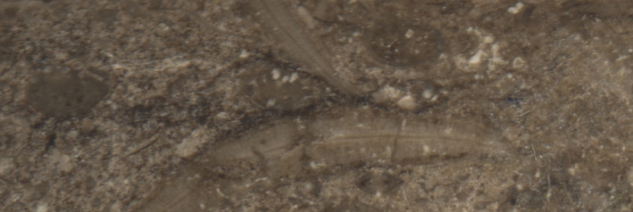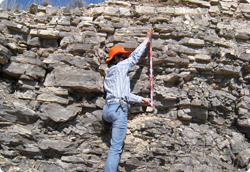
Permian Basin Sedimentary Geochemistry
Paula J. Noble, PhDDepartment of Geological Sciences, University of Nevada, Reno
Use of Geochemical Proxies to Evaluate Paleosalinity
and Carbon Flux
Paula J. Noble, PhDDepartment of Geological Sciences, University of Nevada, Reno
One of the first priorities in petroleum exploration is to understand the basic geology of the area in question. Knowing how old the rocks are and the environments in which they formed determines where best to drill. Paula Noble is refining the tools used to date rocks–specifically, researching the factors that control the distribution of albaillellarians, a group of fossil zooplankton that show large variances in species dominance in the Permian Basin.
 Graduate student Yuxi (Ivy) Jin measuring section and taking samples from a road cut of Lamar Limestone.
Graduate student Yuxi (Ivy) Jin measuring section and taking samples from a road cut of Lamar Limestone.
Factors such as changes in salinity, changes in temperature and climate, ocean currents, and upswelling all affect distribution of these microfossils. The more Dr. Noble and her team can learn about what controls the distribution of albaillellarians in the Permian basin, the better scientists will become at predicting where to find material of an equivalent age at other locations.
“Every five or six years, it seems that there is a new geochemical tool that allows us to try and independently, as a proxy, determine what these ancient environmental variations were,” says Noble. The tool that excites her the most these days relates to organic biomarkers. Noble’s co-principal investigator, Dr. Simon Poulson, initiated a collaboration involving one of Noble’s graduate students who minored in Japanese and a colleague in Japan specializing in biomarker chemistry. Through this collaboration, Noble is exploring ancient molecules that are the fingerprints of very specific types of plants. With this information, her team is able to pinpoint fluctuations in the source matter for organic material.
Scientists have long known about microfossil changes; what they didn’t know was why they were changing. Organic biomarkers allow scientists to tell which organisms are producing the oil in the organic material residue left in rocks, which opens the door for research on climate and vegetation in the area and basin formation. “It almost makes all the other tools we’ve used in the past look like stone hammers,“ says Noble. “Now we finally have some very, very accurate ways of looking at the molecular level at source and climate.”
“When we wrote the grant, I was aware that the section we were working on was just below a major extinction event, but it really wasn’t on my radar screen,” Noble states. “We are seeing some signatures in the geochemistry that indicate that the global carbon cycle has been disrupted. If you have changes in how much carbon you have being used by plants then you can actually see that in the rock record, just by variations versus light and heavy carbon in different rock layers. These mass disruptions in the biota may explain these very large vacillations that we see in the isotope record.” Globally, these vacillations have been recognized in places in Asia and Antarctica. Through Dr. Noble’s research, they are being seen for the first time in West Texas.
Dr. Noble’s favorite element of the project has been watching her students mature, particularly Sarah, the graduate student with a minor in Japanese. “We have a solid collaboration between two universities on the international level, we have a free exchange of students going both ways, and postdoctoral associates and my students are able to do a fairly high tech and specialized cutting edge type of chemical research that would not have been possible here because we don’t have the facilities or the expertise.”




